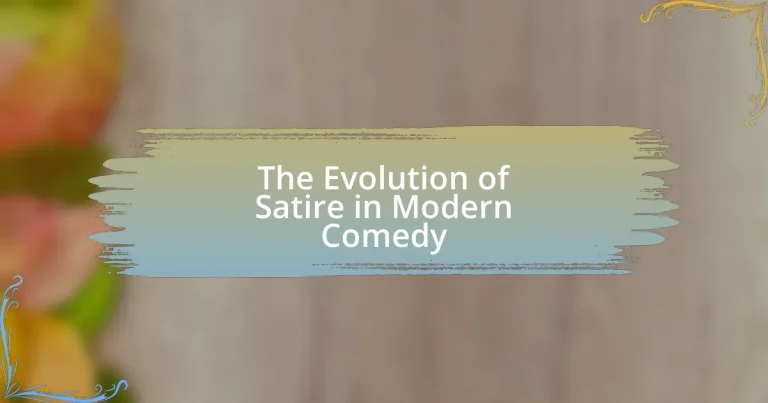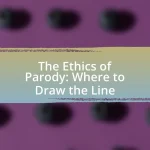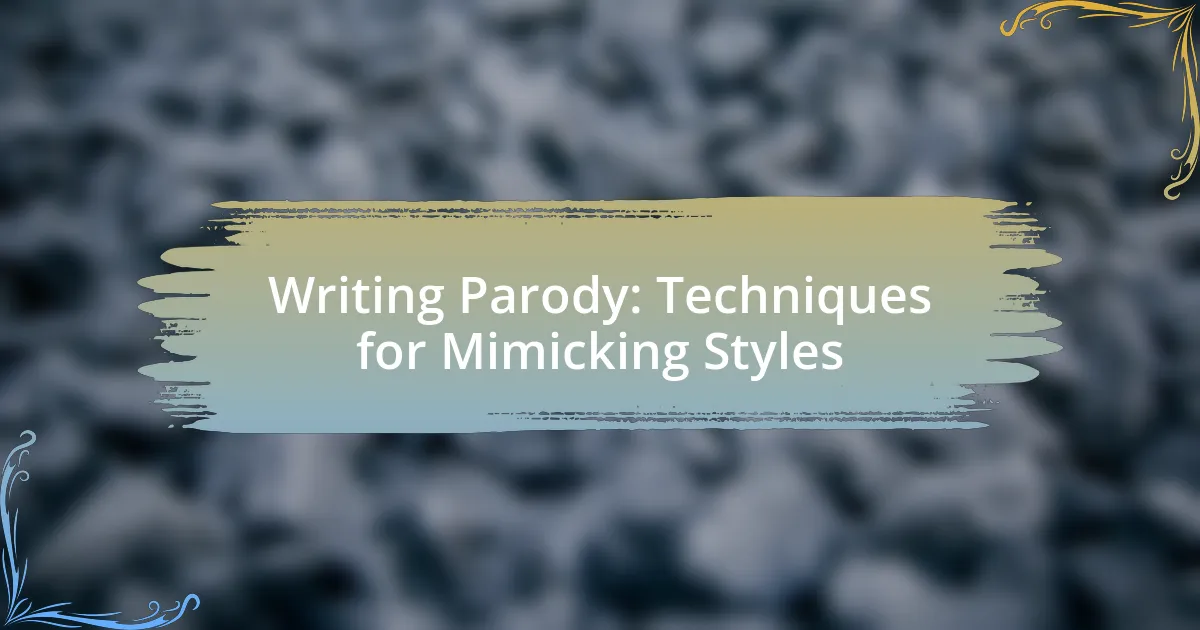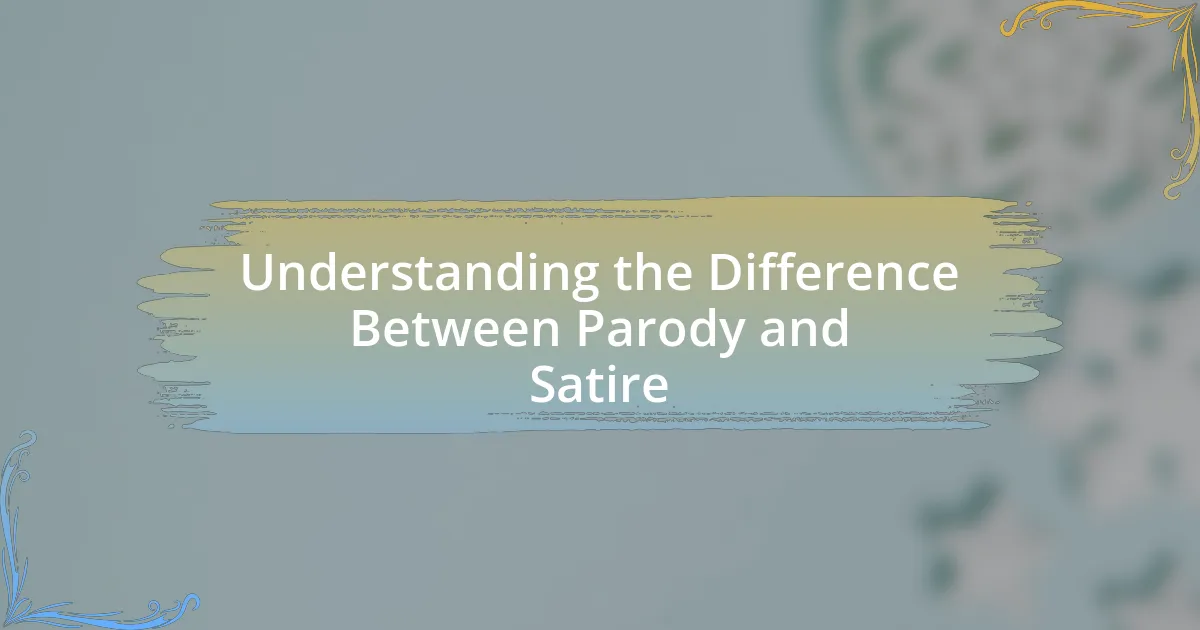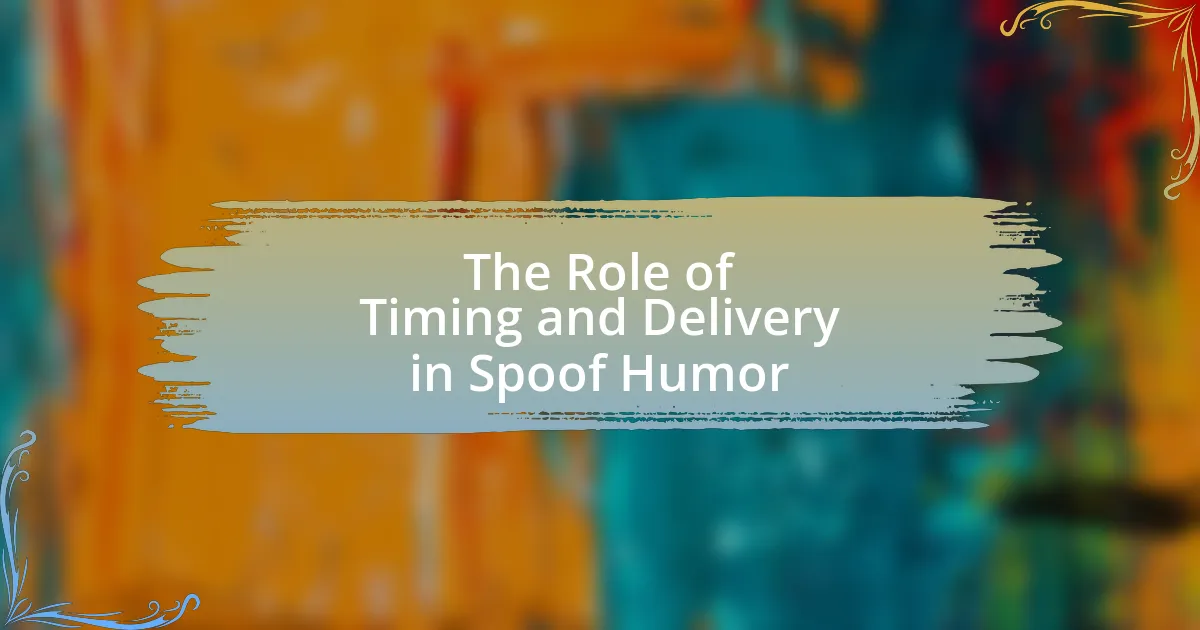The article examines the evolution of satire in modern comedy, highlighting its transition from traditional forms to diverse expressions influenced by historical contexts and technological advancements. It defines modern satire as a genre that employs humor, irony, and exaggeration to critique societal norms and political issues, drawing on historical influences from ancient literature to contemporary television. The piece discusses how modern satire differs from traditional forms, emphasizing the role of digital platforms and social media in shaping its landscape. Additionally, it explores the significance of satire in contemporary society, addressing various social issues and its impact on public discourse, while also identifying key characteristics and techniques used in modern satirical comedy. Prominent examples and influential comedians are highlighted, showcasing their unique approaches and the broader implications of satire in shaping cultural narratives.
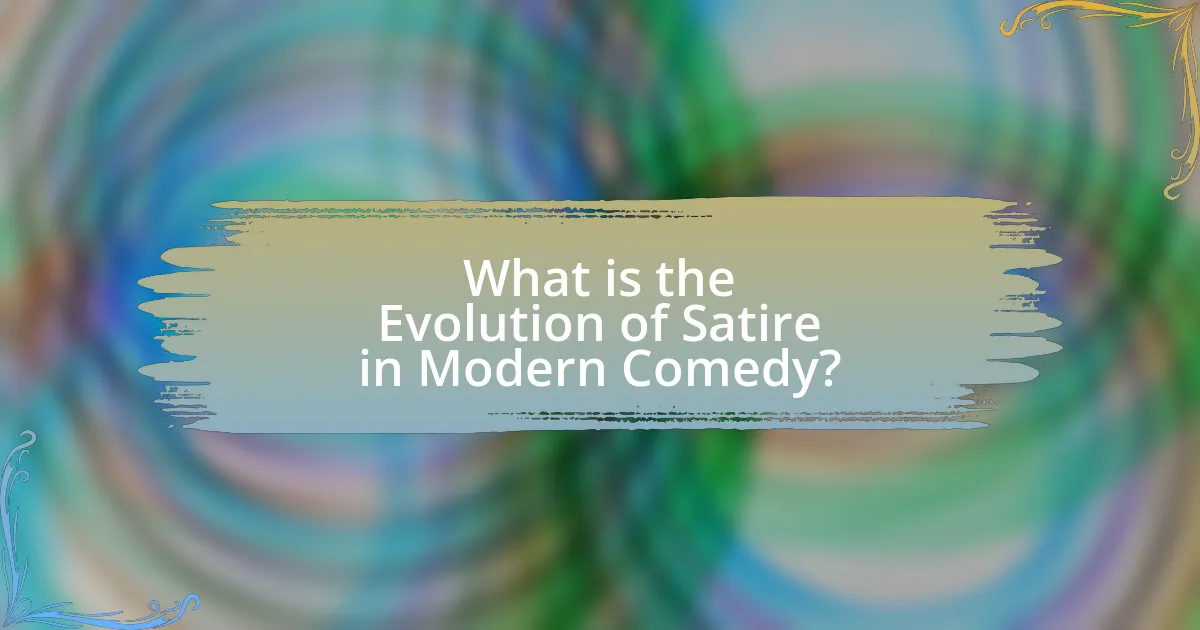
What is the Evolution of Satire in Modern Comedy?
The evolution of satire in modern comedy reflects a shift from traditional forms to more diverse and nuanced expressions. Initially, satire focused on political and social critique, as seen in works by figures like Jonathan Swift and Mark Twain, who used humor to challenge societal norms and injustices. In the late 20th century, television shows like “Saturday Night Live” and “The Daily Show” adapted satire to address contemporary issues, utilizing irony and parody to engage audiences. The rise of the internet further transformed satire, allowing for rapid dissemination and the emergence of platforms like social media, where comedians like John Oliver and Hasan Minhaj blend humor with investigative journalism. This evolution demonstrates satire’s adaptability and its role in shaping public discourse, as it increasingly incorporates diverse perspectives and responds to global events.
How has satire been defined in the context of modern comedy?
Satire in the context of modern comedy is defined as a genre that uses humor, irony, and exaggeration to criticize or mock societal norms, politics, and human behavior. This definition is supported by the prevalence of satirical shows like “Saturday Night Live” and “The Daily Show,” which employ comedic techniques to address current events and social issues, thereby influencing public discourse. Additionally, modern satire often blends various comedic styles, including parody and absurdism, to enhance its critique, reflecting the complexities of contemporary society.
What historical influences shaped the definition of satire?
The definition of satire has been shaped by various historical influences, including ancient Greek and Roman literature, the Renaissance, and the Enlightenment. Ancient Greek playwrights like Aristophanes utilized humor to critique societal norms and politics, establishing a foundation for satire as a tool for social commentary. Roman satirists such as Horace and Juvenal further developed the genre, focusing on moral and ethical issues within society. The Renaissance revived classical ideas, leading to a flourishing of satirical works that challenged authority and questioned religious dogma. The Enlightenment emphasized reason and individualism, inspiring satirists like Jonathan Swift and Voltaire to use wit to expose hypocrisy and advocate for social reform. These historical contexts collectively contributed to the evolving definition of satire as a means of critique and reflection on human behavior and societal structures.
How does modern satire differ from traditional forms?
Modern satire differs from traditional forms primarily in its use of digital platforms and social media to reach audiences instantly and interactively. Traditional satire often relied on print media, theater, or television, which limited the immediacy and scope of its impact. For instance, modern satirical content can be disseminated through memes, tweets, and viral videos, allowing for rapid response to current events and a more participatory audience engagement. This shift has led to a more fragmented and diverse landscape of satire, where voices from various backgrounds can contribute, contrasting with the more centralized and often elitist nature of traditional satire.
Why is satire important in contemporary comedy?
Satire is important in contemporary comedy because it serves as a powerful tool for social critique and reflection. By using humor to expose and ridicule societal flaws, satire encourages audiences to question norms and engage in critical thinking about political, cultural, and social issues. For instance, shows like “Saturday Night Live” and “The Daily Show” effectively use satire to comment on current events, influencing public opinion and sparking conversations about important topics. This relevance is supported by studies indicating that satirical content can enhance audience awareness and understanding of complex issues, making it a vital component of modern comedic expression.
What social issues does satire address in modern society?
Satire in modern society addresses various social issues, including political corruption, social inequality, and cultural norms. Political corruption is often highlighted through exaggerated portrayals of politicians and government actions, revealing the absurdities and failures within the political system. Social inequality is critiqued by showcasing disparities in wealth, race, and gender, prompting audiences to reflect on systemic injustices. Additionally, satire challenges cultural norms and societal expectations, using humor to question and provoke thought about accepted behaviors and beliefs. These issues are prevalent in contemporary satirical works, such as television shows like “Saturday Night Live” and “The Daily Show,” which regularly comment on current events and societal trends, illustrating the power of satire as a tool for social critique.
How does satire contribute to public discourse?
Satire contributes to public discourse by providing a critical lens through which societal issues can be examined and discussed. It uses humor, irony, and exaggeration to highlight the absurdities and contradictions within political and social systems, prompting audiences to reflect on these issues. For example, shows like “Saturday Night Live” and “The Daily Show” have historically influenced public opinion by addressing current events and political figures, often leading to increased awareness and engagement among viewers. Research indicates that exposure to satirical content can enhance political knowledge and encourage civic participation, as evidenced by studies from the Pew Research Center, which found that younger audiences who consume satire are more likely to discuss political topics and participate in elections.
What are the key characteristics of modern satirical comedy?
Modern satirical comedy is characterized by its sharp critique of societal norms, political issues, and cultural phenomena through humor. This form of comedy often employs irony, exaggeration, and absurdity to highlight the flaws and contradictions in contemporary life. For instance, shows like “Saturday Night Live” and “The Daily Show” utilize current events and public figures as subjects for satire, effectively engaging audiences while provoking thought about serious topics. Additionally, modern satirical comedy frequently incorporates multimedia elements, such as social media and digital platforms, to reach wider audiences and enhance its impact, reflecting the evolving landscape of communication in the digital age.
How do humor and critique coexist in modern satire?
Humor and critique coexist in modern satire by using comedic elements to highlight societal flaws and provoke thought. Satirists employ irony, exaggeration, and wit to entertain while simultaneously delivering pointed commentary on political, social, and cultural issues. For instance, shows like “Saturday Night Live” and “The Daily Show” blend humor with critical analysis, allowing audiences to engage with serious topics in a digestible format. This duality is effective because it encourages reflection and discussion, making the critique more impactful. Research indicates that humor can enhance the reception of critical messages, as it lowers defenses and fosters openness to new ideas, thereby reinforcing the effectiveness of satire as a tool for social commentary.
What techniques are commonly used in satirical comedy today?
Common techniques used in satirical comedy today include exaggeration, parody, irony, and social commentary. Exaggeration amplifies characteristics or behaviors to highlight absurdities, while parody imitates styles or works to critique them. Irony creates a contrast between expectations and reality, often revealing deeper truths, and social commentary addresses current events or societal issues, prompting reflection and discussion. These techniques are prevalent in various media, including television shows like “Saturday Night Live” and online platforms, where they effectively engage audiences and provoke thought.
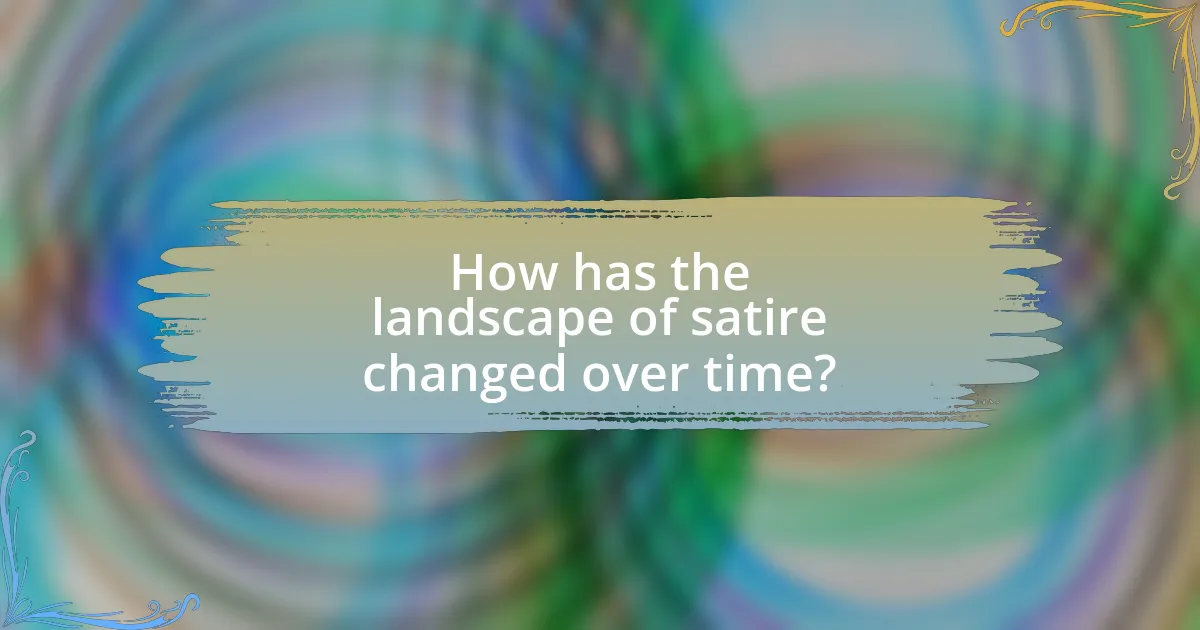
How has the landscape of satire changed over time?
The landscape of satire has evolved significantly from traditional forms to contemporary digital expressions. Historically, satire was primarily found in literature and theater, exemplified by works from authors like Jonathan Swift and Voltaire, who used sharp wit to critique societal norms and politics. In the 20th century, television programs like “Saturday Night Live” and “The Daily Show” popularized satirical commentary, adapting to current events and engaging a broader audience.
With the rise of the internet and social media, satire has become more immediate and accessible, allowing for rapid dissemination and interaction. Platforms like Twitter and YouTube have enabled satirists to reach global audiences instantly, often blurring the lines between satire and misinformation. This shift has led to a more fragmented landscape where traditional gatekeepers of satire are less influential, and diverse voices can emerge.
The change in satire’s landscape reflects broader societal shifts, including the increasing polarization of political discourse and the impact of technology on communication.
What historical milestones mark the evolution of satire in comedy?
The evolution of satire in comedy is marked by several historical milestones, including the works of ancient Greek playwrights like Aristophanes, who used comedic plays to critique political figures and societal norms in the 5th century BCE. The Roman poet Juvenal further developed satire in the 1st century CE, focusing on moral and social commentary. The Renaissance period saw the rise of satirical literature, exemplified by writers such as Rabelais and Cervantes, who employed humor to challenge authority and societal conventions. In the 18th century, Jonathan Swift’s “A Modest Proposal” exemplified the use of satire to address serious social issues through irony and exaggeration. The 20th century introduced satirical forms in media, with programs like “Saturday Night Live” and “The Daily Show” using humor to critique contemporary politics and culture. Each of these milestones reflects the ongoing evolution of satire as a tool for social commentary and critique in comedy.
How did the advent of television influence satirical comedy?
The advent of television significantly transformed satirical comedy by providing a mass platform for immediate and widespread dissemination of comedic content. Television allowed satirical shows, such as “Saturday Night Live” and “The Daily Show,” to reach large audiences quickly, enabling them to comment on current events and societal issues in real-time. This immediacy fostered a new form of engagement, as viewers could see their political and social realities reflected and critiqued through humor. The visual medium also enhanced the comedic impact, allowing for the use of visual gags, impersonations, and live performances that were not possible in print or radio formats. Consequently, television became a crucial vehicle for satire, shaping public discourse and influencing political opinions, as evidenced by the significant cultural impact of shows that addressed contemporary issues and events.
What role did the internet play in the evolution of satire?
The internet significantly transformed satire by providing a platform for rapid dissemination and democratization of satirical content. This shift allowed satirists to reach wider audiences instantly, bypassing traditional media gatekeepers. For example, platforms like social media enable users to share satirical memes and videos, amplifying their reach and impact. Additionally, the internet fosters a participatory culture where audiences can engage with and create their own satirical content, as seen in the rise of user-generated platforms like YouTube and TikTok. This evolution has led to a more diverse range of voices in satire, reflecting various perspectives and social issues, thereby enriching the genre.
How have cultural shifts impacted satirical content?
Cultural shifts have significantly impacted satirical content by altering the themes, targets, and methods of satire. For instance, the rise of social media has enabled satirists to reach wider audiences and respond more rapidly to current events, as seen in platforms like Twitter where satirical commentary on political issues can go viral within hours. Additionally, changing societal norms around race, gender, and politics have led to a reevaluation of what is considered acceptable in satire, prompting creators to navigate these sensitivities carefully. The shift towards inclusivity and representation has also influenced satirical content, as seen in shows like “Saturday Night Live,” which has diversified its cast and storylines to reflect a broader range of perspectives. These adaptations demonstrate how cultural dynamics shape the evolution of satire, making it a responsive and relevant form of commentary.
What changes in audience perception have influenced satire?
Changes in audience perception that have influenced satire include increased awareness of social issues and a demand for authenticity in comedic content. As audiences have become more socially conscious, they expect satire to address relevant topics such as inequality, politics, and cultural norms. This shift is evidenced by the rise of satirical programs like “The Daily Show” and “Saturday Night Live,” which have adapted their content to reflect contemporary societal concerns and engage with their audience’s values. Additionally, the proliferation of social media has allowed audiences to interact with satire in real-time, further shaping its direction and effectiveness.
How do global events shape the themes of modern satire?
Global events significantly shape the themes of modern satire by providing relevant and relatable material for satirists to critique societal norms, political issues, and cultural phenomena. For instance, events such as the COVID-19 pandemic have led to a surge in satire addressing public health responses, government actions, and social behaviors, as seen in works by comedians like John Oliver and Trevor Noah. Additionally, political events, such as elections and international conflicts, often serve as focal points for satire, allowing creators to highlight absurdities and injustices, as evidenced by the widespread satirical commentary during the 2020 U.S. presidential election. This connection between global events and satire not only reflects public sentiment but also influences the direction and impact of comedic narratives in contemporary society.
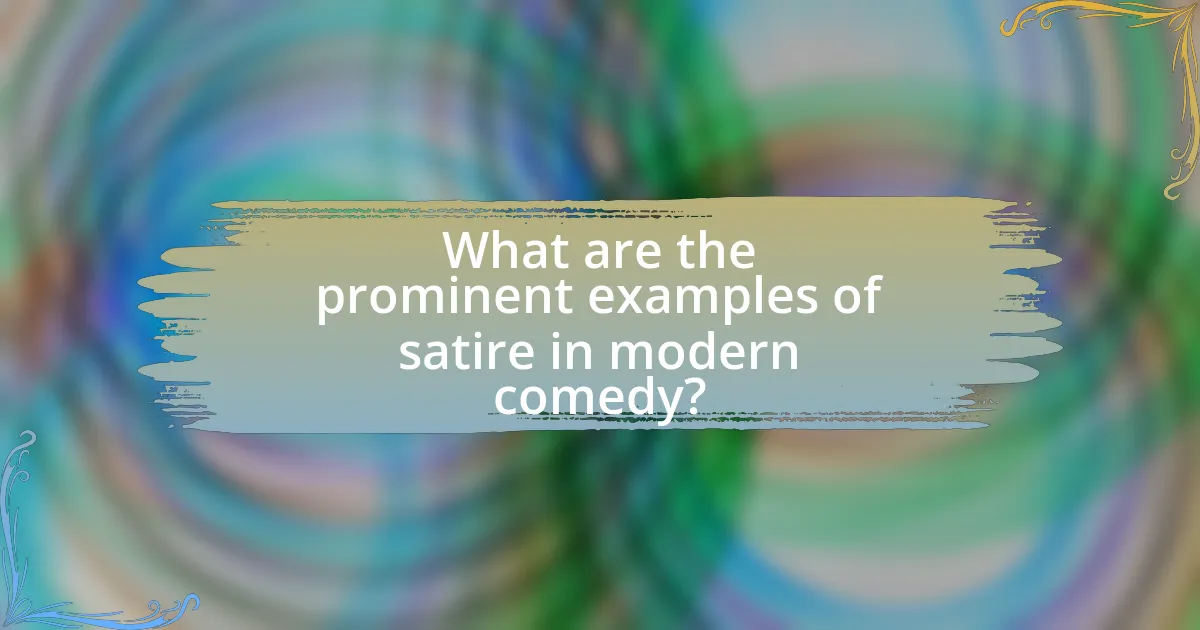
What are the prominent examples of satire in modern comedy?
Prominent examples of satire in modern comedy include “Saturday Night Live,” “The Daily Show,” and “South Park.” “Saturday Night Live” utilizes sketch comedy to critique political figures and societal issues, often reflecting current events with humor. “The Daily Show” employs satirical news reporting to expose the absurdities in politics and media, influencing public perception and discourse. “South Park” uses animated satire to address controversial topics, pushing boundaries and provoking thought on social norms. These shows exemplify how satire serves as a tool for social commentary, engaging audiences while highlighting the flaws in contemporary culture and politics.
Which comedians are known for their satirical work?
Comedians known for their satirical work include Jon Stewart, John Oliver, and George Carlin. Jon Stewart gained prominence as the host of “The Daily Show,” where he used humor to critique political and social issues, influencing public discourse. John Oliver, through his show “Last Week Tonight,” employs deep dives into current events, blending comedy with investigative journalism, which has garnered multiple Emmy Awards. George Carlin is renowned for his incisive commentary on language, politics, and societal norms, often challenging conventional wisdom and provoking thought through his stand-up routines. These comedians exemplify the use of satire to address and reflect on contemporary issues, making significant contributions to the genre.
What makes their approach to satire unique?
Their approach to satire is unique due to its blend of sharp wit and social commentary that directly engages contemporary issues. This method not only entertains but also provokes critical thought among audiences, making them reflect on societal norms and injustices. For instance, shows like “The Daily Show” and “Saturday Night Live” utilize current events as a backdrop for their satire, effectively highlighting absurdities in politics and culture. This relevance to real-time events distinguishes their satire from traditional forms, which often relied on historical or fictional contexts.
How have their styles evolved over time?
The styles of satire in modern comedy have evolved significantly from sharp, overt political commentary to more nuanced, character-driven humor. Early satirical works often relied on direct ridicule of political figures and societal norms, as seen in the works of Jonathan Swift and George Carlin, who used blunt humor to provoke thought and critique authority. Over time, the emergence of platforms like television and the internet has led to a diversification of styles, incorporating elements of absurdism and self-referential humor, as exemplified by shows like “The Daily Show” and “Saturday Night Live.” This evolution reflects a shift towards more complex narratives that engage audiences through irony and social commentary, adapting to changing cultural contexts and audience sensibilities.
What are the most influential satirical shows or films?
The most influential satirical shows and films include “Saturday Night Live,” “The Daily Show,” “South Park,” and “Dr. Strangelove.” “Saturday Night Live,” which debuted in 1975, has shaped political satire through its live sketches and impersonations, influencing public perception of political figures. “The Daily Show,” particularly under Jon Stewart’s tenure, provided critical commentary on news media and politics, winning numerous awards and reshaping late-night television. “South Park,” known for its irreverent humor, critiques societal norms and politics, becoming a cultural touchstone since its 1997 premiere. “Dr. Strangelove,” a 1964 film directed by Stanley Kubrick, satirizes Cold War fears and nuclear conflict, remaining a classic example of film satire. Each of these works has significantly impacted the landscape of satire in modern comedy, reflecting and shaping societal attitudes.
How do these works reflect societal issues?
Modern comedic works reflect societal issues by using satire to critique social norms, political systems, and cultural behaviors. For instance, shows like “Saturday Night Live” and “The Daily Show” address contemporary political events and social injustices, highlighting issues such as inequality, corruption, and systemic racism. These programs often employ humor to provoke thought and encourage dialogue among audiences, making complex societal problems more accessible. Research indicates that satire can effectively raise awareness and influence public opinion, as evidenced by studies showing that viewers of satirical content are more likely to engage in political discussions and activism.
What impact have they had on the comedy genre?
They have significantly transformed the comedy genre by introducing sharp, socially relevant satire that critiques contemporary issues. This evolution has led to a more engaged audience, as seen in shows like “Saturday Night Live” and “The Daily Show,” which blend humor with political commentary, influencing public discourse. The incorporation of satire has also expanded the boundaries of comedy, allowing for a diverse range of voices and perspectives, as evidenced by the rise of comedians like John Oliver and Hasan Minhaj, who tackle complex subjects with humor, thereby reshaping audience expectations and the role of comedy in society.
What practical tips can enhance the effectiveness of satire in comedy?
To enhance the effectiveness of satire in comedy, comedians should focus on clarity, relevance, and timing. Clarity ensures that the audience understands the underlying message, while relevance connects the satire to current events or societal issues, making it more impactful. Timing is crucial; delivering the punchline at the right moment can amplify the comedic effect. For instance, the success of shows like “Saturday Night Live” often hinges on their ability to address timely political issues with sharp wit, demonstrating how effective satire resonates when it aligns with audience awareness and sentiment.
How can comedians balance humor and critique effectively?
Comedians can balance humor and critique effectively by using satire that highlights societal issues while maintaining an entertaining delivery. This approach allows comedians to engage audiences with laughter, making them more receptive to critical messages. For instance, shows like “The Daily Show” utilize humor to address political and social topics, demonstrating that comedic commentary can provoke thought and discussion. Research indicates that humor can enhance the retention of critical messages, as audiences are more likely to remember information presented in an entertaining format. This method not only entertains but also encourages reflection on important issues, exemplifying the successful integration of humor and critique in modern comedy.
What strategies can be used to engage audiences with satire?
To engage audiences with satire, creators can employ strategies such as using relatable humor, incorporating current events, and utilizing exaggeration. Relatable humor connects with the audience’s experiences, making the satire more impactful; for instance, shows like “Saturday Night Live” often draw on everyday situations that resonate with viewers. Incorporating current events ensures the satire remains relevant and timely, as seen in programs like “The Daily Show,” which critiques political happenings. Exaggeration amplifies the absurdity of the subject matter, effectively highlighting flaws in societal norms or behaviors, a technique famously used by Jonathan Swift in “A Modest Proposal.” These strategies collectively enhance audience engagement by making satire accessible and thought-provoking.
